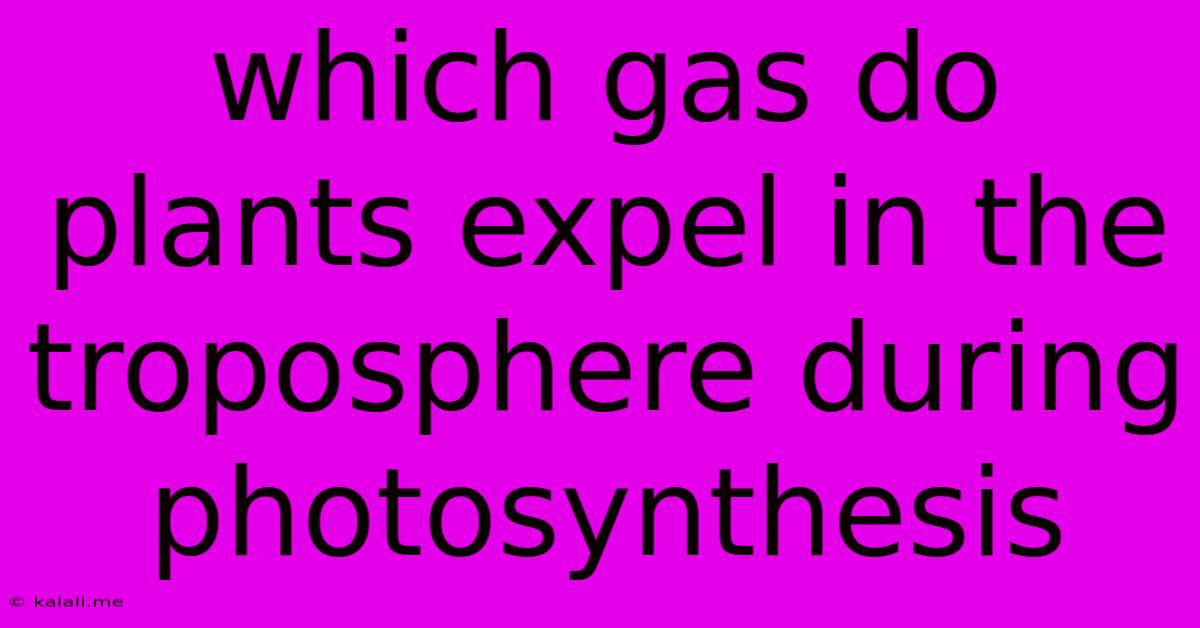Which Gas Do Plants Expel In The Troposphere During Photosynthesis
Kalali
Jun 14, 2025 · 3 min read

Table of Contents
Which Gas Do Plants Expel in the Troposphere During Photosynthesis?
Meta Description: Discover the gas plants release into the troposphere during photosynthesis, its crucial role in the carbon cycle, and the impact of this process on Earth's atmosphere. Learn about the vital connection between plant life and atmospheric composition.
Photosynthesis, the remarkable process by which plants convert light energy into chemical energy, plays a pivotal role in maintaining the Earth's atmosphere and supporting life as we know it. While plants absorb carbon dioxide (CO2) during this process, they also release another gas: oxygen (O2). This oxygen is expelled into the troposphere, the lowest layer of Earth's atmosphere, where it becomes available for respiration by animals and other organisms.
The Photosynthesis Equation: A Closer Look
The simplified equation for photosynthesis is often represented as:
6CO₂ + 6H₂O + Light Energy → C₆H₁₂O₆ + 6O₂
This equation shows that six molecules of carbon dioxide (CO₂) and six molecules of water (H₂O) react in the presence of light energy to produce one molecule of glucose (C₆H₁₂O₆), a simple sugar that serves as food for the plant, and six molecules of oxygen (O₂). It's the oxygen (O₂) produced as a byproduct that's released into the troposphere.
Oxygen's Role in the Atmosphere
The oxygen released during photosynthesis is crucial for the survival of most life forms on Earth. Aerobic organisms, including humans and many animals, require oxygen for cellular respiration, the process that converts the energy stored in glucose into a usable form. This process, the inverse of photosynthesis, consumes oxygen and releases carbon dioxide, creating a continuous cycle.
The Carbon Cycle and Photosynthesis
Photosynthesis also plays a significant role in the carbon cycle, the process by which carbon is exchanged between the atmosphere, oceans, land, and living organisms. By absorbing atmospheric CO₂, plants help regulate the concentration of this greenhouse gas, mitigating the effects of climate change. The carbon atoms from the absorbed CO₂ are incorporated into the plant's structure and used to build its biomass (leaves, stems, roots, etc.).
Factors Affecting Oxygen Production
Several environmental factors can influence the rate of photosynthesis and, consequently, the amount of oxygen produced. These factors include:
- Light intensity: Higher light intensity generally leads to increased photosynthetic rates and oxygen production, up to a saturation point.
- Carbon dioxide concentration: Increased CO₂ levels can also boost photosynthesis, but only up to a certain point; beyond that, other factors become limiting.
- Temperature: Photosynthesis is most efficient within a specific temperature range. Extreme temperatures can negatively impact the process.
- Water availability: Water is a crucial reactant in photosynthesis; insufficient water supply can significantly reduce oxygen production.
Conclusion: A Breath of Fresh Air
In summary, the gas plants expel in the troposphere during photosynthesis is oxygen. This seemingly simple process is incredibly complex and vitally important for maintaining the Earth's atmosphere, regulating the carbon cycle, and supporting the vast diversity of life on our planet. Understanding the intricacies of photosynthesis is crucial for addressing environmental challenges, like climate change, and ensuring the health of our planet for future generations. Further research into optimizing photosynthesis and its efficiency is a crucial area of ongoing scientific investigation.
Latest Posts
Latest Posts
-
All Of The Following Are Projective Assessment Techniques Except
Jun 14, 2025
-
Real Life Applications Of Linear Equations In Two Variables
Jun 14, 2025
-
What Does The Area Under Velocity Time Graph Represent
Jun 14, 2025
-
What Are The Factors For 92
Jun 14, 2025
-
Which Word Is An Antonym Of Immoral
Jun 14, 2025
Related Post
Thank you for visiting our website which covers about Which Gas Do Plants Expel In The Troposphere During Photosynthesis . We hope the information provided has been useful to you. Feel free to contact us if you have any questions or need further assistance. See you next time and don't miss to bookmark.